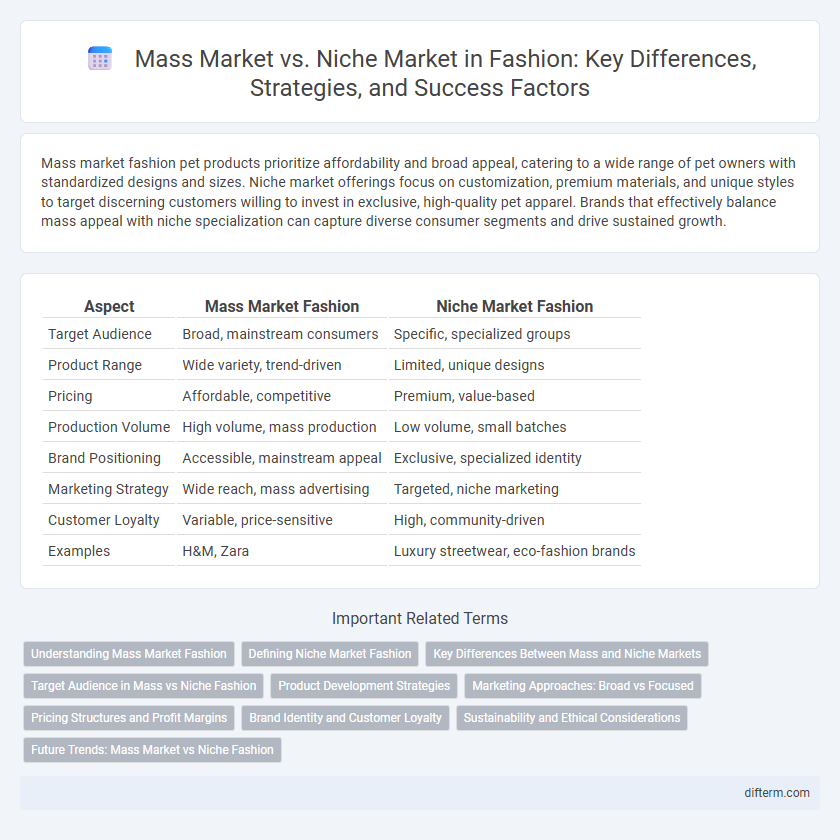Mass market fashion pet products prioritize affordability and broad appeal, catering to a wide range of pet owners with standardized designs and sizes. Niche market offerings focus on customization, premium materials, and unique styles to target discerning customers willing to invest in exclusive, high-quality pet apparel. Brands that effectively balance mass appeal with niche specialization can capture diverse consumer segments and drive sustained growth.
Table of Comparison
| Aspect | Mass Market Fashion | Niche Market Fashion |
|---|---|---|
| Target Audience | Broad, mainstream consumers | Specific, specialized groups |
| Product Range | Wide variety, trend-driven | Limited, unique designs |
| Pricing | Affordable, competitive | Premium, value-based |
| Production Volume | High volume, mass production | Low volume, small batches |
| Brand Positioning | Accessible, mainstream appeal | Exclusive, specialized identity |
| Marketing Strategy | Wide reach, mass advertising | Targeted, niche marketing |
| Customer Loyalty | Variable, price-sensitive | High, community-driven |
| Examples | H&M, Zara | Luxury streetwear, eco-fashion brands |
Understanding Mass Market Fashion
Mass market fashion targets a broad audience with affordable, trend-driven apparel and accessories produced at scale by major brands like H&M and Zara. This segment emphasizes rapid product turnover and widespread availability in department stores and online platforms, catering to consumers seeking accessible and contemporary styles. Understanding mass market fashion involves analyzing consumer behavior, supply chain efficiency, and competitive pricing strategies to maintain relevance in a fast-paced industry.
Defining Niche Market Fashion
Niche market fashion targets specific consumer segments with unique style preferences, often emphasizing limited editions, sustainable materials, or cultural influences. Brands in this sector prioritize quality, exclusivity, and personalized shopping experiences to differentiate themselves from mass market fashion, which focuses on high volume and trend-driven products. This approach allows niche fashion labels to build loyal customer bases and command premium pricing in a competitive industry.
Key Differences Between Mass and Niche Markets
Mass markets in fashion target a broad audience with affordable, trend-driven apparel emphasizing high volume and accessibility, often utilizing extensive distribution channels. Niche markets focus on specific consumer segments, offering unique, high-quality, or specialized products that cater to distinct tastes or needs, such as sustainable fashion or luxury craftsmanship. Key differences include product variety, pricing strategy, marketing approach, and the degree of customer engagement, with mass markets relying on mass appeal and niches fostering brand loyalty through personalization.
Target Audience in Mass vs Niche Fashion
Mass market fashion targets a broad audience seeking affordable, trendy apparel with wide accessibility, often prioritizing volume and price over exclusivity. Niche market fashion caters to specific segments with unique preferences, such as sustainable materials or avant-garde designs, attracting consumers who value differentiation and specialized products. Understanding these distinct target audiences enables brands to tailor marketing strategies and product development effectively, maximizing engagement and loyalty.
Product Development Strategies
Mass market fashion product development strategies prioritize broad consumer appeal, leveraging trend forecasting and cost-efficient manufacturing to maximize volume and scale. Niche market strategies emphasize unique, high-quality materials and limited production runs to cater to specific customer segments seeking exclusivity and personalization. Data-driven insights and agile design processes enable brands to respond swiftly to evolving preferences within both markets.
Marketing Approaches: Broad vs Focused
Mass market fashion brands employ broad marketing approaches targeting wide demographics through extensive advertising on diverse platforms to maximize reach and sales volume. Niche market fashion brands use focused marketing strategies that cater to specific consumer segments, emphasizing personalized messaging, exclusivity, and curated content to build strong brand loyalty. Leveraging data analytics, niche marketers tailor campaigns for higher engagement, while mass market strategies prioritize brand awareness and product accessibility.
Pricing Structures and Profit Margins
Mass market fashion brands typically adopt competitive pricing structures with lower profit margins to attract a broad customer base through high-volume sales. Niche market brands often implement premium pricing strategies, leveraging unique designs and exclusivity to achieve higher profit margins despite lower sales volumes. Understanding these distinct approaches enables fashion companies to tailor their pricing and marketing tactics effectively for target audiences.
Brand Identity and Customer Loyalty
Mass market fashion brands emphasize broad appeal and consistent branding to establish strong brand identity, driving high customer loyalty through familiarity and accessibility. Niche market brands cultivate unique, specialized identities that resonate deeply with targeted customer segments, fostering intense loyalty and community engagement. Both approaches leverage distinct brand narratives to maintain customer retention and competitive positioning in the fashion industry.
Sustainability and Ethical Considerations
Mass market fashion prioritizes affordability and wide availability, often leading to increased waste and unethical labor practices due to its fast production cycles. Niche markets emphasize sustainability by using eco-friendly materials and transparent supply chains, promoting ethical labor standards and reduced environmental impact. Consumers increasingly choose niche brands to support slow fashion movements that value quality and responsible consumption.
Future Trends: Mass Market vs Niche Fashion
The future of fashion reveals a growing divergence between mass market and niche market strategies, with mass market brands leveraging data-driven personalization to enhance accessibility and scale, while niche brands capitalize on exclusivity and sustainable practices to attract discerning consumers. Advances in AI and digital fashion enable mass market players to rapidly respond to trends, yet niche markets emphasize craftsmanship and unique identity to maintain cultural relevance. Consumer demand for ethical production and customization is reshaping both segments, driving innovation and reshaping retail landscapes in the evolving fashion ecosystem.
mass market vs niche market Infographic

 difterm.com
difterm.com